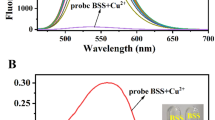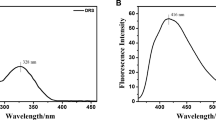Abstract
A 1,8-naphthalimide derivative with a reactive aliphatic hydroxyl was designed and synthesized as a fluorescent probe. Its structure was characterized by IR, 1H NMR, 13C NMR, LC-MS and HPLC. The probe showed high selectivity and sensitivity to Hg2+ over other metal ions such as Pb2+, Na+, K+, Cd2+, Cr3+, Zn2+, Cu2+, Ni2+, Ca2+, Fe3+, Fe2+, Co2+, Mn2+ and Mg2+ in MeCN/H2O (15/85, v/v). The increase in fluorescence intensity was linearly proportional to the concentration of Hg2+ in the range of 18–40 μM with a detection limit of 1.38 × 10−7 mol/L. The probe could work in a pH span of 4.3–9.0 and respond to Hg2+ quickly with strong anti-interference ability. Job’s plot suggested a 1:2 complex of the probe and Hg2+.














Similar content being viewed by others
References
Zhang QF, Li YW, Liu ZH, Chen QL (2016) Reproductive toxicity of inorganic mercury exposure in adult zebrafish: histological damage, oxidative stress, and alterations of sex hormone and gene expression in the hypothalamic-pituitary-gonadal axis. Aquat Toxicol 177:417–424
Jatwani C, Gupta RK, Rai R, Bansal N (2016) Effects of Hg/Co toxicity in soil on biomolecules of earthworm, eisenia fetida. Procedia Environ Sci 35:450–455
Dutta M, Das D (2012) Recent developments in fluorescent sensors for trace-level determination of toxic-metal ions. TrAC, trends anal. Chem 32:113–132
Jeong YS, Yoon JY (2012) Recent progress on fluorescent chemosensors for metal ions. Inorg Chim Acta 381:2–14
Qian XH, Xu ZC (2015) Fluorescence imaging of metal ions implicated in diseases. Chem Soc Rev 44:4487–4493
Ozdemir M (2016) A rhodamine-based colorimetric and fluorescent probe for dual sensing of Cu2+ and Hg2+ ions. J Photochem Photobio A 318:7–13
Liu WM, Chen JH, Xu LW, Wu JS, Xu HT, Zhang HY, Wang PF (2012) Reversible “off-on” fluorescent chemosensor for Hg2+ based on rhodamine derivative. Spectrochim. Acta Part A 85:38–42
Li M, Jiang YH, Zhang D, Ding PG, Wang ZJ, Ye Y, Zhao YF (2014) A novel colorimetric and off-on fluorescent sensor for Hg2+ and its application in live cell imaging. J Lumin 148:219–224
Li XT, Yin Y, Deng JJ, Zhong HX, Tang J, Chen Z, Yang LT, Ma LJ (2016a) A solvent-dependent fluorescent detection method for Fe3+ and Hg2+ based on a rhodamine B derivative. Talanta 154:329–334
Tharmaraj V, Pitchumani K (2012) An acyclic, dansyl based colorimetric and fluorescent chemosensor for Hg(II) via twisted intramolecular charge transfer (TICT). Anal Chim Acta 751:171–175
Kumar A, Kim HS (2015) N-(3-Imidazolyl)propyl dansylamide as a selective Hg2+ sensor in aqueous media through electron transfer. Spectrochim. Acta Part A 148:250–254
Zhou S, Zhou ZQ, Zhao XX, Xiao YH, Xi G, Liu JT, Zhao BX (2015) A dansyl based fluorescence chemosensor for Hg2+ and its application in the complicated environment samples. Spectrochim. Acta Part A 148:348–354
Wang K, Yang LX, Zhao C, Ma HM (2013) 4-(8-Quinolyl)amino-7-nitro-2,1,3-benzoxadiazole as a new colorimetric probe for rapid and visual detection of Hg2+. Spectrochim. Acta Part A 105:29–33
Chebrolu LD, Thurakkal S, Balaraman HS, Danaboyina R (2014) Selective and dual naked eye detection of Cu2+ and Hg2+ ions using a simple quinoline-carbaldehyde chemosensor. Sens. Actuators B 204:480–488
Ma WH, Xu Q, Du JJ, Song B, Peng XJ, Wang Z, Li GD, Wang XF (2010) A Hg2+-selective chemodosimeter based on desulfurization of coumarin thiosemicarbazide in aqueous media. Spectrochim. Acta Part A 76:248–252
Yu SY, Wu SP (2014) A highly selective turn-on fluorescence chemosensor for Hg(II) and its application in living cell imaging. Sens. Actuators B 201:25–30
Kao SL, Wu SP (2015) A fluorescent turn-on probe for Hg(II) based on an NTe2 chelating motif and its application in living cell imaging. Sens. Actuators B 212:382–388
He T, Lin CL, Gu ZY, Xu LN, Yang AL, Liu YY, Fang HJ, Qiu HY, Zhang J, Yin SC (2016) Sensing behavior and logic operation of a colorimetric fluorescence sensor for Hg2+/Cu2+ ions. Spectrochim. Acta Part A 167:66–71
Shen W, Wang L, Wu M, Bao XF (2016) A fluorescein derivative FLTC as a chemosensor for Hg2+ and Ag+ and its application in living-cell imaging. Inorganic Chem Commun 70:107–110
Piyanuch P, Watpathomsub S, Lee VS, Nienaber HA, Wanichacheva N (2016) Highly sensitive and selective Hg2+-chemosensor based on dithia-cyclic fluorescein for optical and visual-eye detections in aqueous buffer solution. Sens. Actuators B 224:201–208
Gong WT, Gao B, Zhao JZ, Ning GL (2013) Rational design of a reusable chemodosimeter for the selective detection of Hg2+. J Mater Chem A 1:5501–5504
Zhang ZC, Wu D, Guo XF, Qian XH, Lu Z, Xu Q, Yang YY, Duan LP, He YK, Feng Z (2015a) Visible study of mercuric ion and its conjugate in living cells of mammals and plants. Chem Res Toxicol 18:1812–1820
Li CY, Xu F, Li YF, Zhou K, Zhou Y (2012) A fluorescent chemosensor for Hg2+ based on naphthalimide derivative by fluorescence enhancement in aqueous solution. Anal Chim Acta 717:122–126
Liu B, Tian H (2005) A selective fluorescent ratiometric chemodosimeter for mercury ion. Chem Commun :3156–3158. doi:10.1039/b501913c
Wanichacheva N, Prapawattanapol N, Lee VS, Grudpan K, Petsom A (2013) Hg2+-induced self-assembly of a naphthalimide derivative by selective “turn-on” monomer/excimer emissions. J Lumin 134:686–690
Leng B, Zou L, Jiang JB, Tian H (2009) Colorimetric detection of mercuric ion (Hg2+) in aqueous media using chemodosimeter-functionalized gold nanoparticles. Sens. Actuators B 140:162–169
Chen T, Zhu WP, Xu YF, Zhang SY, Zhang XJ, Qian XB (2010) A thioether-rich crown-based highly selective fluorescent sensor for Hg2+ and Ag+ in aqueous solution. Dalton Trans 39:1316–1320
Mu HL, Gong R, Ma Q, Sun YM, Fu EQ (2007) A novel colorimetric and fluorescent chemosensor: synthesis and selective detection for Cu2+ and Hg2+. Tetrahedron Lett 48:5525–5529
Hou C, Urbanec AM, Haishi Cao HS (2011) A rapid Hg2+ sensor based on aza-15-crown-5 ether functionalized 1,8-naphthalimide. Tetrahedron Lett 52:4903–4905
Fang CL, Zhou J, Liu XJ, Cao ZH, Shangguan DH (2011) Mercury(II)-mediated formation of imide-Hg-imide complexes. Dalton Trans 40:899–903
Tian ZD, Liu YC, Tian BZ, Zhang JL (2015) The synthesis and fluorescence properties of novel 1,8-naphthalimide derivatives. Res Chem Intermed 41:1157–1169
Zhou YM, Zhang JL, Zhang L, Zhang QY, Ma TS, Niu JY (2013) A rhodamine-based fluorescent enhancement chemosensor for the detection of Cr3+ in aqueous media. Dyes Pigments 97:148–154
Fang XX, Zhang SF, Zhao GY, Zhang WW, Xua JW, Ren AM, Wu CQ, Yang W (2014) The solvent-dependent binding modes of a rhodamine-azacrown based fluorescent probe for Al3+ and Fe3+. Dyes Pigments 101:58–66
Li Y, Qiu YX, Zhang JJ, Zhu XY, Zhu B, Liu XY, Zhang XY, Zhang HX (2016b) Naphthalimide derived fluorescent probes with turn-on response for Au3+ and the application for biological visualization. Biosens Bioelectron 83:334–338
Dodangeh M, Gharanjig K, Arami M (2016) A novel Ag+ cation sensor based on polyamidoamine dendrimer modified with 1,8-naphthalimide derivatives. Spectrochim. Acta Part A 154:207–214
Zhang ZY, Lu SZ, Sha CM, Xu DM (2015b) A single thiourea-appended 1,8-naphthalimide chemosensor for three heavy metal ions: Fe3+, Pb2+, and Hg2+. Sens. Actuators B 208:258–266
Acknowledgements
This work was supported by the National Natural Science Foundation of China (21074085), the Priority Academic Program Development of Jiangsu Higher Education Institutions, and the State and Local Joint Engineering Laboratory for Novel Functional Polymeric Materials.
Author information
Authors and Affiliations
Corresponding authors
Electronic supplementary material
ESM 1
(DOC 398 kb)
Rights and permissions
About this article
Cite this article
Lv, F., Chen, Y., Tang, T. et al. A New Reactive 1,8-Naphthalimide Derivative for Highly Selective and Sensitive Detection of Hg2+ . J Fluoresc 27, 1285–1292 (2017). https://doi.org/10.1007/s10895-017-2061-y
Received:
Accepted:
Published:
Issue Date:
DOI: https://doi.org/10.1007/s10895-017-2061-y




